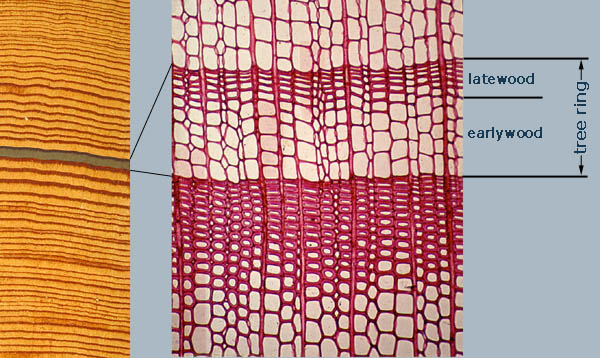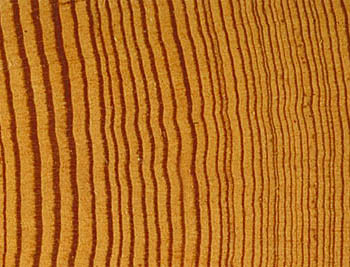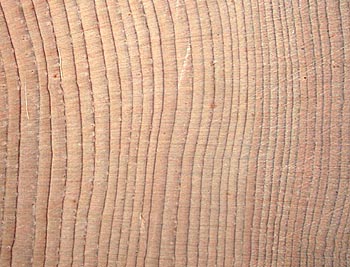 |
|
|
|
|
|
|
Throughout most of the world's temperate regions, trees
form during the vegetative period one growth ring per year. Tree rings
consits of two layers: the earlywood
and the latewood. At the beginning of
the vegetative period, trees build the wide, thin-walled cells of the
earlywood within only a few days. Wide earlywood cells are very important
for water transport in spring when the trees need water for germination.
Towards the end of the vegetative period, dense, thick-walled cells
of the latewood are formed. Latewood cells thicken continously over several
weeks. They contribute mainly to the stability of the tree. |

1 - Tree rings and cells of a Larix decidua (European larch) |
|
In high altitudes, radial growth in trees takes place over a period of three to four months. About 80% of the tree ring is built up in the first month of the vegetative period (June to July (Müller H N 1988)). From August to September the tree makes latewood cells. In general narrow tree rings are often the result of cool, moist climatic conditions. Dense latewood cells are formed when summer temperatures are high, weak latewood cells when summer temperatures are low. Curves of the maximum latewood density are highly correlated with summer temperatures (August to September). Tree ring density curves therefore can be used for paleotemperature analyses (Schweingruber et al. 1978, 1991, 1993). In the Alps at the upper timberline, the forest limit is
formed by coniferous trees (see forest communities),
mainly by Pinus cembra (Alpine stone pine), Larix
decidua (European larch) and Picea abies (Norway spruce). The tree rings of
these species are macroscopically well visible and the change from latewood
to earlywood is abrupt. The European larch shows very distinct tree rings
due to the light earlywood and dark latewood (Figure 2), whereas the
Alpine stone pine shows lighter tree rings (Figure 3). |
|
|
|
| 2 - Tree rings from Larix decidua (European Larch). | 3 - Tree rings from Pinus cembra (Swiss stone pine). |
| |
|
What can tree rings tell us about environmental influences during the lifetime of a tree? The living conditions of a tree at the forest limit are very harsh. The extreme environmental conditions reigning in the subalpine zone are reflected in the rate of tree ring growth and in the physiognomy of a tree. During its life, a tree is influenced by a combination of several environmental factors shown in Figure 4 below: Explore the cross-section of a Larix decidua (European larch) at the centre: |
 4 - Combination of several environmental factors affecting the tree during his lifetime |
| |
|
Schweingruber F H, Tree Rings. Basics and Applications of Dendrochronology, 1988 Schweingruber F H, Tree Rings and Environment. Dendroecology, 1996 |
29 August 2011 |
||
| |
||

